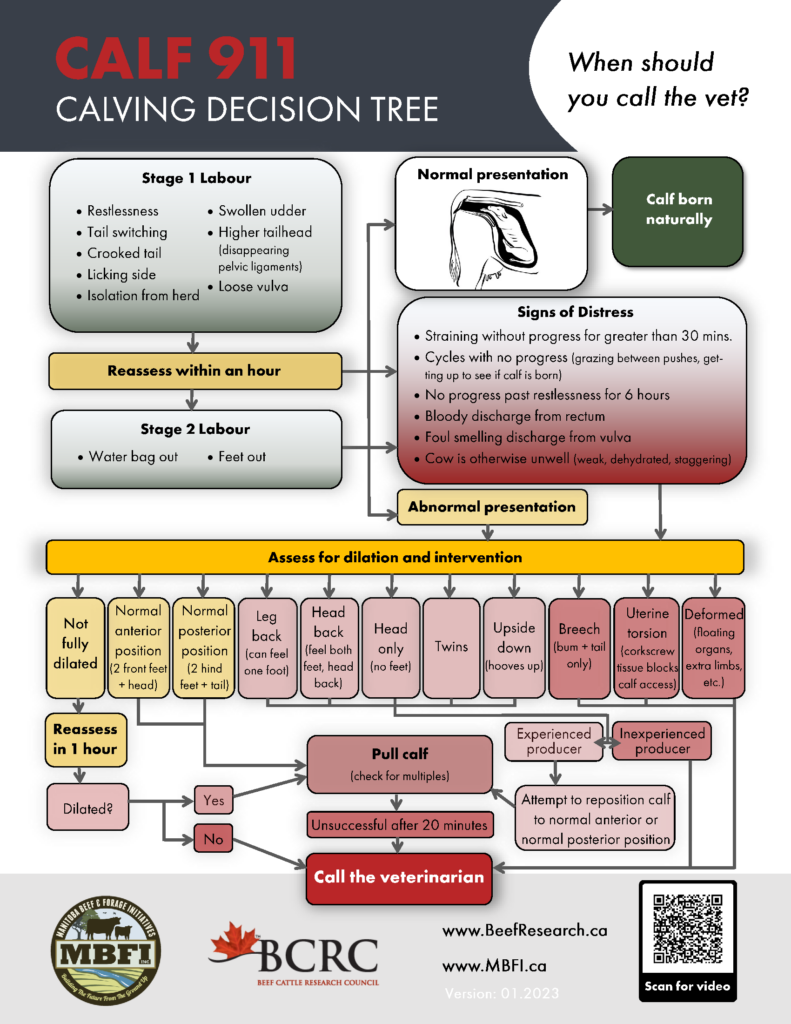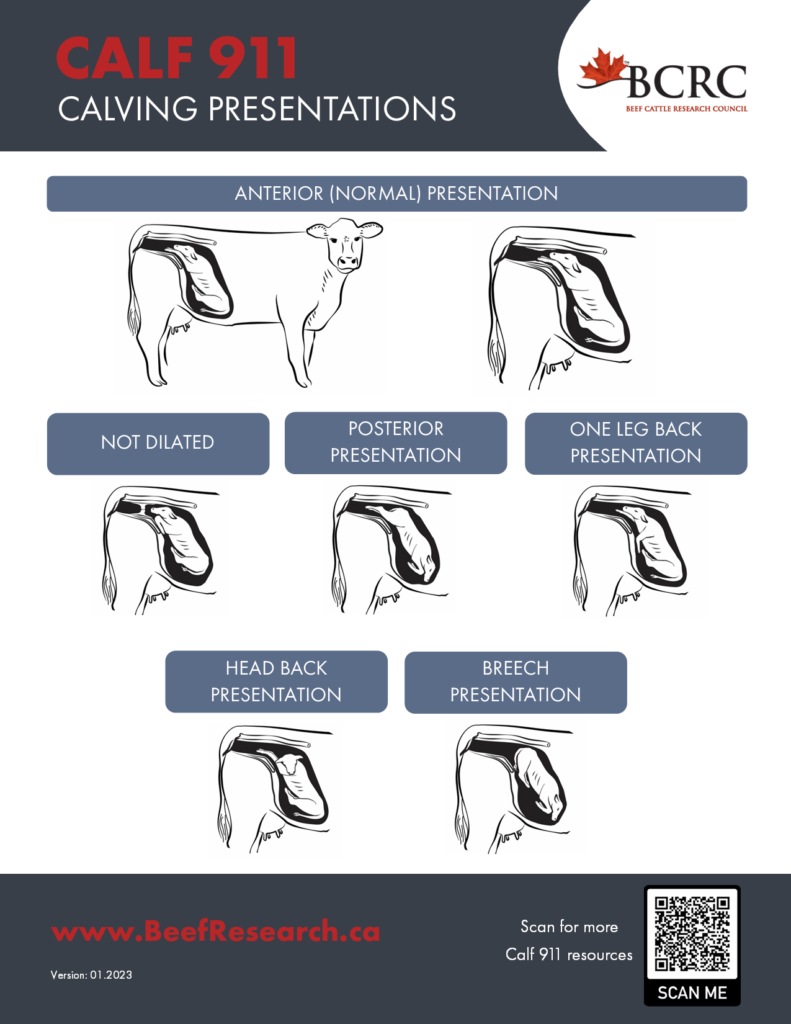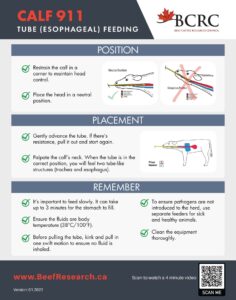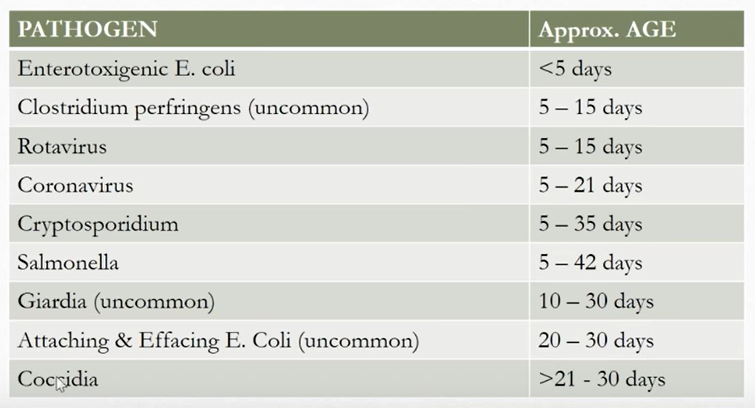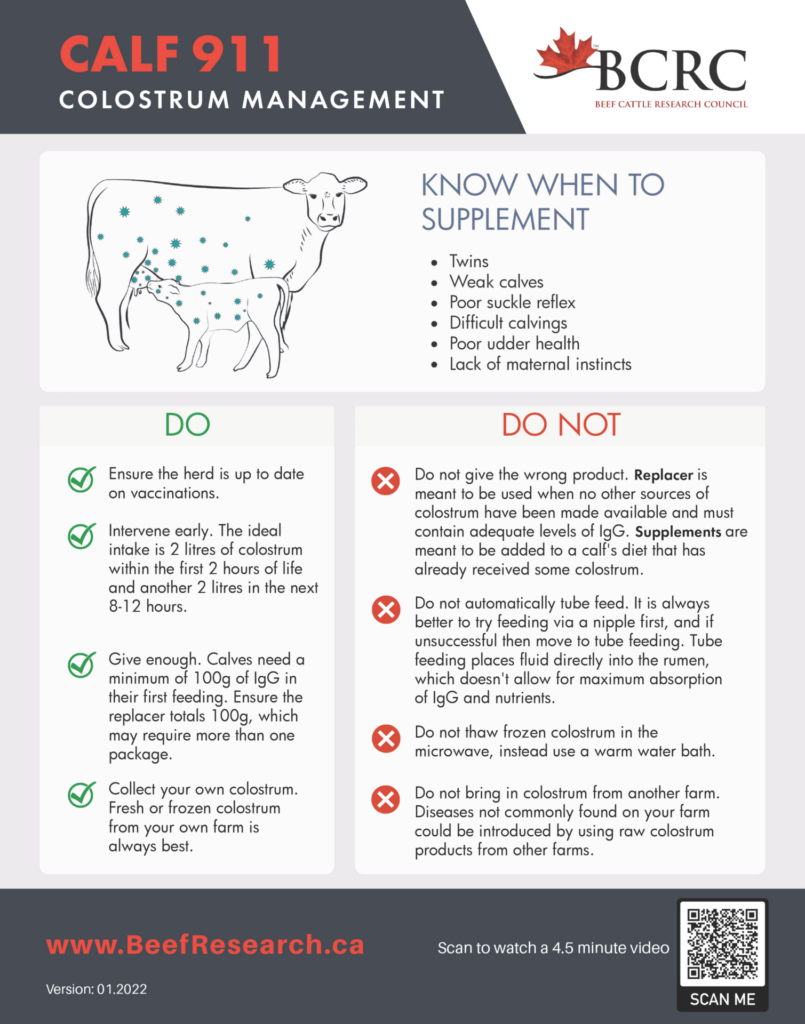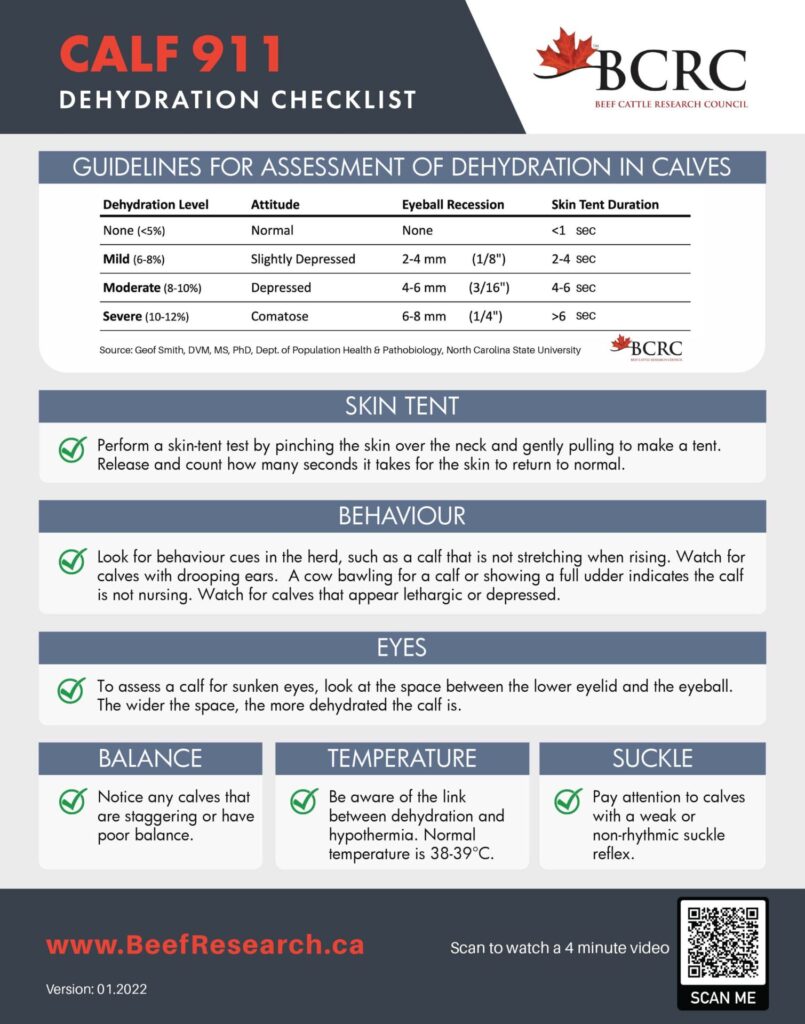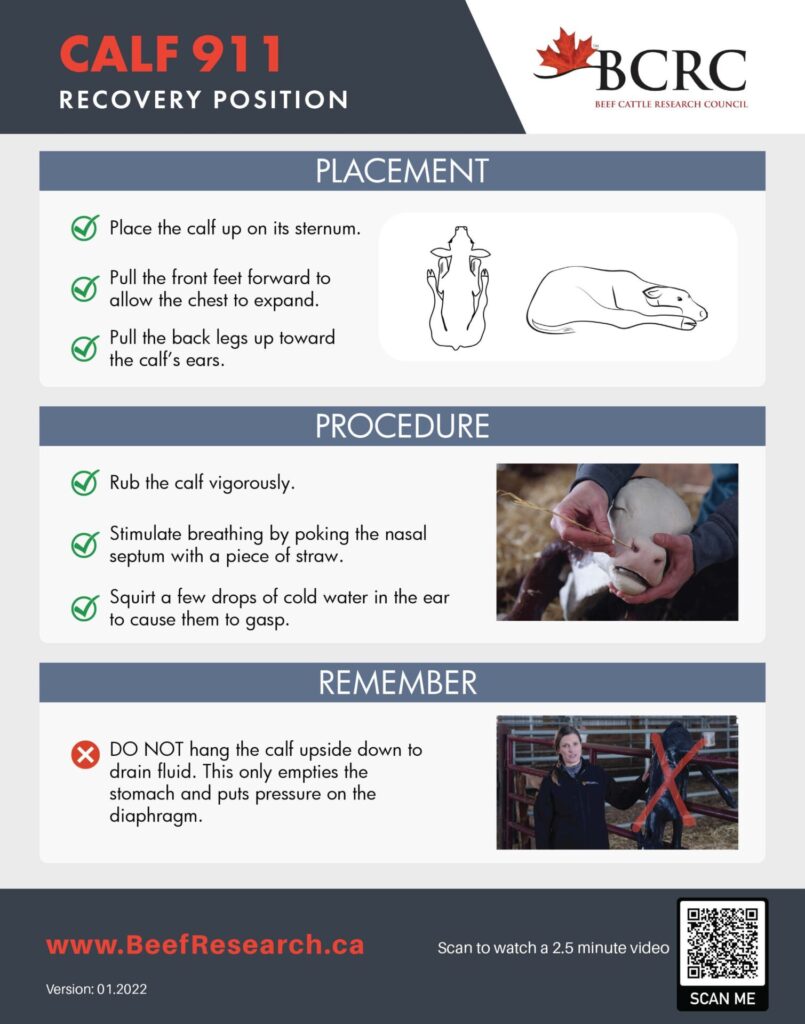Calving systems, management, and timing varies greatly across the country and from farm to farm. That being said, there are some common goals across all systems including having a live, healthy calf as well as maintaining the health of the cow and preparing her for a successful re-breeding. Many factors influence achieving this including dystocia (or calving difficulties), disease, injuries, and weather. Management practices can play a role in reducing death loss in calves.
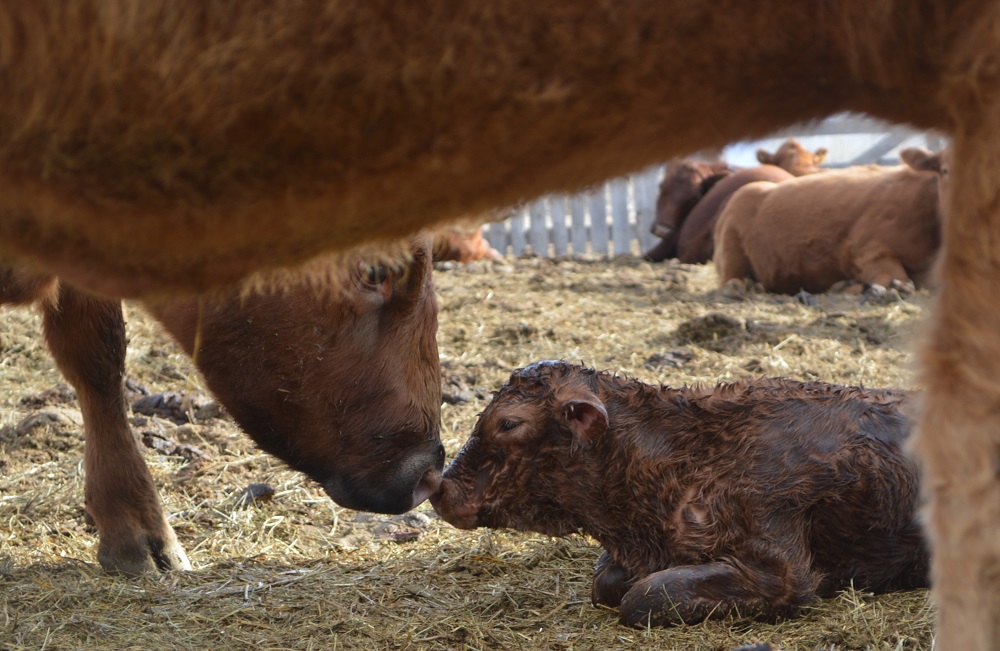
| Key Points |
|---|
| Early intervention to reduce losses during calving |
| Calving heifers, which may be at higher risk for dystocia, 2-3 weeks prior to cows allows for concentrated surveillance |
| Producers can minimize dystocia by choosing the appropriate sires for cow size and development, maintaining cows at a body condition score of 3-3.5, and selecting cattle for the environment |
| Once a water bag appears, a calf should hit the ground within one hour for cows or up to one and a half hours for a first-calf heifer |
| Timely assistance can lead to up to a 9% increase in the number of animals cycling at the onset of the breeding season and a 14% increase in pregnancy rate |
| If a calf is born needing resuscitation, it is recommended to use the calf recovery position, straw in their nose, water in their ear, or to rub vigorously. These techniques are recommended over hanging the calf upside down |
| Calves that do not receive adequate amounts of colostrum immediately after birth are at a much higher risk of becoming sick and are also more likely to die |
| Simply testing the suckle reflex of calves provides a good indication if the calf needs to be supplemented with colostrum |
| Many of the disease agents that cause diseases such as scours in young calves are already in the herd and are often found in the manure of cows within the herd. Ensuring calving areas are clean and dry and that calves have adequate colostrum will be the best disease prevention |
| Calves that are grafted onto a cow should be from within the producer’s own herd to prevent disease transfer |
Calving and Calf Management in Beef Cattle
Limited data is available across Canada, but recent surveys suggest the industry average is a 4-8% death loss from birth to weaning on calves born from cows. This report also found that calves born to heifers had greater mortality rates during the first 24 hours than calves born to cows. This underlines the importance of early intervention to reduce losses during calving. These same surveys also found that the main cause of calf mortality was:
- Dystocia (calving difficulties)
- Scours/diarrhea
- Predators
- Pulmonary/respiratory disease
- Weather

Calving management is a year-round process and the effort to wean healthy, heavy calves starts long before the calving season. Selecting bulls and replacement females that are healthy and fit with the environment and the overall goals of each individual program, maintaining proper biosecurity by washing clothes and boots worn on other farms, controlling visitors, and quarantining new animals or those who have been off farm all help to keep calves disease free. Managing the nutrition and mineral supplementation of cows year-round, including grazing management plans, as well as an up to date vaccine protocol, all tie back to having healthy, vigorous calves. Planning is often the key difference between herds that enjoy good calf health and herds that struggle with calf disease.
Calve Heifers Early
There are a number of reasons to calve heifers before cows, but calving heifers, which may be at higher risk for dystocia, 2-3 weeks prior to cows allows for concentrated surveillance. Early calving for heifers also allows them to calve in the cleanest calving environment, especially if it is not possible to move the herd and calving of the entire herd occurs in one location. This will help reduce the risk of disease in calves born to heifers. Although this helps to reduce the disease burden, it is not a substitute for other management procedures that reduce disease. Heifers also need more time to return to estrus than cows do, since it takes them longer to start cycling after they have had a calf. Breeding them early gives them a chance to catch up with the cows and be bred early in the breeding season next year. This greatly increases their chance of remaining in the herd longer.
Dystocia Management

Besides being a problem at the time of birth, dystocia is related to higher incidence of disease and preweaning mortality. When calves have difficult births, they are also less likely to receive adequate amounts of colostrum in the critical first hours of life resulting in a weakened immune system and a higher chance of health challenges throughout their life.
Dystocia can directly cause a calf’s death or indirect losses by increasing the susceptibility to infectious disease. Calves that survive dystocia have been shown to be 2.4 times more likely to become sick during the first 45 days of life. A study looking at herds in western Canada found that calves that were assisted at birth were 10-15% more likely to be treated for disease and had a 9-18% higher chance of mortality.
Dystocia is a complex issue that is influenced by a number of factors including genetics, cow management, age of cow, number of calves, fetal presentation, and nutrition. While producers can minimize dystocia by choosing the appropriate sires for cow size and development, maintaining cows at a body condition score of 3-3.5, and selecting cattle for the environment, some instances of dystocia are likely to occur. Through the Western Canadian Cow-Calf Surveillance Network, researchers found that average herd level of assisted calving was 4.9%. While that number may look relatively small, 90% of producers assisted at least one calf during the previous calving season so dystocia does have profound impacts on the bottom line. Figure 2 below shows the impact death loss can have on a herd and the increase in weaning weights required to make up the loss.

While some cases of dystocia are unavoidable, it is possible to minimize the effect it can have on a calf by:
- Calving heifers prior to cows
- Ensuring facilities are equipped for calving season
- Ensuring calving area is clean, dry, and well bedded
- Knowing when to intervene
- Use of proper resuscitation techniques if needed (use the calf recovery position rather than hanging calves upside down)
- Ensuring adequate colostrum intake (sufficient volume of good quality colostrum as soon as possible after birth)
- Administering a pain control product
- Managing your pastures/pens during calving season to reduce the risk of disease spread
- Paying attention to calves born with difficult births for early signs of disease
- Treating disease in young calves early with appropriate therapy
When to Intervene
Intervening at the wrong time during calving can result in unnecessary stress, injury, or even death of the cow and/ or calf. Producers should be familiar with the normal sequence of calving. Every scenario is different, however once a water bag appears, a calf should hit the ground within one hour for cows or up to one and a half hours for a first-calf heifer.
Timely assistance in the calving process affects subsequent reproductive capacity of the dam. Timely assistance can lead to up to a 9% increase in the number of animals cycling at the onset of the breeding season and a 14% increase in the fall pregnancy rate. Furthermore, timely assistance will greatly increase the chance of a live calf if a cow does have dystocia.
The following calving decision tree was developed in partnership with Manitoba Beef & Forage Initiatives (MBFI). It is a visual tool that can be used to help identify what the process of calving should look and feel like. The flow chart can also assist with step-by-step decision making when calving is not progressing normally. This information can help in making informed decisions and aid in communicating vital information to veterinary staff if veterinary care is required.
The flow chart follows the cow from the first stage of labour when subtle changes in behaviour and physical appearance first begin and progresses through until the calf is born. If signs of distress or abnormal presentations occur, steps for assessment and interventions are presented.
If calving in winter with an off-farm job, or if labour is an issue, it may be helpful to consider feeding cows later in the day. Research has shown that feeding cows in the evenings can result in a higher percentage of cows calving during daylight hours when it is easier to observe and catch problems early.
Before the calving season, it is recommended to sit down with your veterinarian to discuss a plan, including when to intervene, what you should do when you do decide to intervene, and when it’s time to call the vet for assistance.
Prepare for calving season by printing the Calf 911 Checklists and putting them on your calving barn wall for easy access to calving management tips.
Resuscitation Techniques
If a calf is born needing resuscitation, it is recommended to use the calf recovery position, straw in their nose, water in their ear, or to rub vigorously. These techniques are recommended over hanging the calf upside down. A study of Canadian cow-calf producers showed that over half of beef producers surveyed hung calves upside down to resuscitate them, a method that is not recommended. Hanging upside down causes a calf’s stomach and intestines to press down on the diaphragm and compress the lungs, making it harder for the calf to breathe. Although fluid will come out, it is fluid from the stomach, not the lungs. Instead try one of these four techniques:
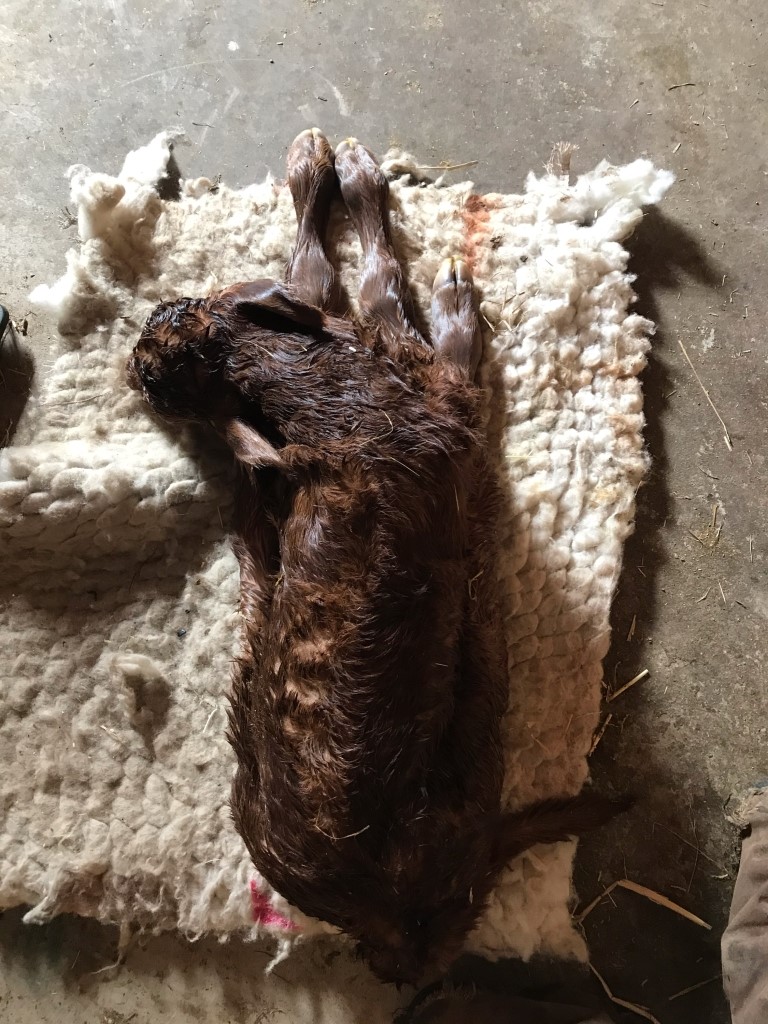
- The calf recovery position: this involves placing the calf in a position that best allows it to breath. Calves are placed with both front legs tucked underneath their chest and back legs on each side of the body, pulled towards its head, which allows the lungs to expand with the least amount of pressure.
- Rub vigorously: by rubbing the calf vigorously shortly after birth, the calf will often ‘wake up’ and start breathing.
- Water in the ear: squirting a few drops of water in a calf’s ear will also cause them to gasp and start breathing. Be careful not to fill the ear with water as this could cause an ear infection.
- Straw in the nose: poking the nasal septum (or piece of skin between the two nostrils) will usually cause the calf to gasp and take a deep breath in and start the breathing process.
Use of Pain Medication
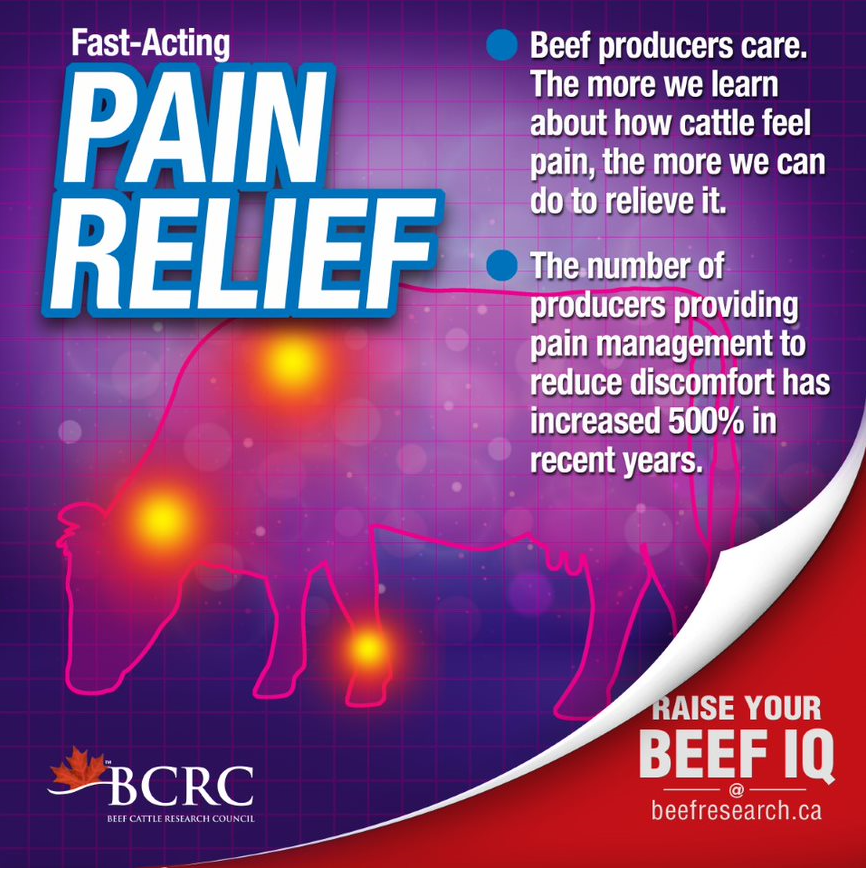
Researchers at the University of Calgary have been looking at the effects of providing a non-steroidal anti-inflammatory drug (or NSAID) such as meloxicam to calves after a difficult birth. Researchers measured a number of physiological indicators of pain in calves but found that ADG only improved in the first week of life for calves given pain control but that those changes evened out over time. Researchers were unable to find any other statistically significant signs of reduced pain in calves provided an NSAIDs versus calves who weren’t. Even though producers didn’t know if they were giving the calves an NSAID or a placebo, they unofficially reported being able to identify which calves were given the NSAID. Producers noticed that calves given NSAIDs looked brighter, mothered up quicker, and were released from the barn sooner.
Colostrum
- Intake of enough good quality colostrum within the first 24 hours after birth is vital to develop a calf’s immunity.
- Two litres of colostrum within the first four to six hours is ideal.
Newborn calves are born with virtually no immunity of their own. The cow’s placenta does not allow antibodies to pass from the mother to the calf during pregnancy, which means the calf must receive its initial immunity from the antibody rich colostrum, or first milk of the cow. This initial immunity is essential because it provides protective antibodies against many of the diseases that affect newborn calves, such as calf scours, navel abscesses, arthritis and pneumonia. The pre-calving vaccines given to cows to prevent scours in calves rely on this passive transfer of immunity in the colostrum.
The calf is only able to absorb antibodies from colostrum within the first 24 hours of life, but the efficiency greatly decreases with time, starting as early as 1 hour after birth. The optimal window of absorption occurs within 4-6 hours of birth. After the gut closes, the antibodies can still have local effect within the gut, but they can no longer be absorbed into the blood stream.
Calves that do not receive adequate amounts of colostrum immediately after birth are at a much higher risk of becoming sick and are also more likely to die. Many cases of diarrhea, navel ill, septicemia, and pneumonia in calves are a result of failing to receive an adequate level of colostral immunity.
The calves that are at the highest risk of failing to receive adequate colostral immunity:
- Had a difficult birth
- Are dumb or have a swollen tongue after birth
- Were abandoned or mismothered
- Were born via c-section
- Are hypothermic in cold weather
- Twins
Large udders, poor udder suspension, and/or large teats can also make suckling difficult, even for vigorous newborn calves. Cows with bad udders should be culled before breeding or at weaning. Look to see if the cow’s teats have been sucked, feel the calf’s belly to see if it is full, or look at its hooves to see if the soft, rubbery capsule has been worn off, an indication that it has been standing up. If it doesn’t look like the calf has what it needs or it appears weak or dull, the following are some supplementation considerations:
- The best source of supplemental colostrum is from within your own herd. The freshly calved cow can be milked, or colostrum can be collected from another cow on farm and frozen for up to one year.
- Never microwave colostrum which can “cook” the antibodies and render them useless. Instead, place the bag of frozen colostrum in a bowl of warm water so it can gradually increase in temperature.
- Powdered colostrum is an option if fresh/frozen colostrum is unavailable. Read the package to determine if the product is a “replacement” or a “supplement.” Supplements contain fewer grams of IgG (antibodies that help provide immunity) per liter so two packages may be required to meet the needs of the calf.
- Veterinarians recommend feeding calves anywhere from a minimum of 100 grams IgG up to 300 grams IgG.
- Avoid colostrum sourced from other farms, to prevent bringing unwanted diseases to the herd.
- When administering colostrum, bottle-feeding is better than tube-feeding. A bottle will support the calf’s suckle reflex which in turn will ensure the optimal amount of antibodies are absorbed in the calf’s gut.
- Tube feeding is better than nothing, however it places the milk directly into the rumen, which doesn’t allow for maximum absorption. Sufficient volume should compensate somewhat.
- Use separately marked tubes or bottles for feeding colostrum and treating sick calves. This will prevent newborn calves from being exposed to disease.
- Clean and disinfect bottles and tubes after each use.
Esophageal Feeding Techniques
Calves that are assisted at birth have a higher risk of failing to get enough colostrum from their dams. Work in western Canada showed that of calves that were assisted, 35% didn’t have adequate antibody levels, and therefore failed to receive transfer of passive immunity from their dams. If calves are assisted at birth watch carefully to make sure they have sucked. If the damn has been transported to the veterinarian for a hard pull or caesarean section, talk to your veterinarian about providing calves with colostrum supplementation at the clinic, as the calf is unlikely to get home, mother up, and suck the cow in time to receive passive immunity.
Recent research has shown that simply testing the suckle reflex of calves provides a good indication if the calf needs to be supplemented with colostrum. If you put two fingers into the calf’s mouth 10 minutes after birth most calves will suck on your fingers. If that reflex is strong the calf is probably fine. If it is weak the calf needs colostrum supplementation. If checking multiple calves at one time wear a new pair of disposable gloves between each or wash your hands between each calf to avoid transferring diseases from calf to calf. If the suckle reflex is weak it is probably best to tube the calf so you can be sure they are getting the proper amount of colostrum in the right time period.
Work with your veterinarian to design a vaccination program to enhance the immunity of the calf to specific diseases. Depending on the area and level of risk, a scours vaccine may be considered. Vaccines for scours are usually given to the cow in late pregnancy to promote the production of specific antibodies against bacteria and viruses that cause neonatal calf diarrhea. However, the calf can only receive these antibodies through the cow’s colostrum to receive the benefit of this protection.
Disease Prevention
Reducing the amount of exposure of young calves to manure is an important aspect of preventing disease in the newborn. Many of the disease agents that cause diseases such as scours in young calves are already in the herd and are often found in the manure of cows within the herd. Ensuring calving areas are clean and dry and that calves have adequate colostrum will be the best disease prevention.

Ultimately the best way to reduce diseases in calves is to minimize the chance they have of coming in contact with pathogens that are present in the cow herd and environment. The following strategies may help:
- Minimize confinement of the cow herd: although it doesn’t work for every management system, being able to calve cows on pasture or in a large area reduces disease pressure as it allows cows and calves more space to spread out and get away from manure contaminated areas
- Utilize separate wintering and calving areas: moving cows to new ground before calving reduces newborn calves’ exposure to manure and disease-causing pathogens that have built up over the winter
- Move cows to calving areas less than two weeks before calving: once again the goal is to limit the amount of time prior to calving that cows are able to contaminate the calving grounds
- Avoid crowding in calving area
- Rotate calving area from year to year
- Remove snow from calving area and provide clean, dry bedding: this not only helps to keep calves warm, it also prevents excess mud when snow starts to melt.
- Try the Sandhills or modified Sandhills Calving System: these systems are designed to rotate cows through calving pastures in a way that reduces the amount of time cows are present to contaminate a calving area
- If providing areas where only calves have access (such as creep feeding or calf condos) ensure they have adequate space and ventilation
- Quarantine sick calves to prevent disease spread to the rest of the herd
- Try for a smaller calving duration. By shortening the time that cows are calving, this limits the number of pathogens newborn calves are exposed to as it limits the time older calves have to get sick and pass them on. Be cautious with this approach though. A short calving season without the space or infrastructure to support it may actually lead to an increase in disease if calves are unable to spread out and reduce the pathogen load.
- Keep pairs in groups with calves the same age: If calving in a confined area it is recommended to keep pairs that have calved within 3 weeks of each other together. Once three weeks have passed start a new pen with any new pairs that are calving. This limits the spread of disease from older calves to younger calves.
- Consider feeding monensin to cows: this reduces fecal shedding of coccidia in cows, reducing the chance that calves can pick them up from dirty bedding packs or barns.

Diseases in Young Calves
Sickness in young calves is usually caused by a handful of diseases and depending on the symptoms there are different treatment options. With all these diseases, prevention and insuring calves are receiving enough colostrum is much more effective than treatment, so talk to your veterinarian about strategies to prevent disease well before the calving season begins.
Scours, or neonatal diarrhea is one of the main causes of calf sickness and is defined as feces with higher than normal water content for at least two days. Scours is often highly contagious, and it is very unlikely that just one animal in the herd will be affected. Scours can be caused by a number of different pathogens or multiple pathogens at once. Different pathogens affect calves at different ages, so when talking to a veterinarian it’s important to know how old the animal was when first treated so they can make the most effective diagnosis. Since most of these pathogens are present in the calf’s environment, management factors that limit calf exposure to pathogens is often more effective than treating the specific disease. It’s also important to note that some forms of scours are zoonotic, meaning they can be transferred to humans. Make sure to wash hands and clothing thoroughly after dealing with scouring calves, and limit exposure for those with weaker immune systems, such as children or older people.
When it comes to scours, the main concern is dehydration. Most calves that die from scours actually die due to dehydration.
Some rules of thumb for rehydrating scouring calves:
- If calves still have a strong suckle reflex, they are most likely only mildly dehydrated and can be provided with oral electrolytes via a bottle. It’s important to note that not all electrolyte supplements have everything a sick calf requires so talk consult a veterinarian about which ones are best to have on hand during calving.
- Calves with more severe dehydration often can’t stand, have sunken eyes, and lack a suckle reflex. These calves are in need of intravenous fluids.
Since many causes of scours are not bacterial, antibiotics don’t often work. Sometimes veterinarians will recommend an antibiotic to treat or prevent secondary infections such as septicemia (more below). Some studies in dairy calves have shown that treating calves with an NSAID speeds up the recovery process for scouring calves but rehydration is essential in these situations because NSAIDS in dehydrated calves can have serious negative side-effects. Besides rehydrating calves, it is important to keep them warm and dry. If calves are not up and sucking or have been separated from their dam it is important to also provide a source of energy such as milk from the dam or a milk replacer product.
Septicemia is an inflammatory response to bacteria or bacterial toxins in the blood. This is often a secondary infection where a bacterial infection elsewhere gets into the bloodstream. There are two main times this occurs, including in young calves (less than two weeks old) that have failed transfer of passive immunity due to not enough colostrum, or when calves get exposed to bacteria, often through a naval infection that results in disease. This disease also often happens in scouring calves. In these calves, even though scours most likely isn’t bacterial, one of the symptoms is damage to the gut lining. In this case, bacteria that enter the calf’s stomach are more likely to cross through into the bloodstream. Clinical signs of septicemia include:
- depression
- fever or hypothermia
- dullness
- loss of appetite
- red gums
- visible blood vessels in the eyes
- with progression, development of a weak pulse and cold extremities.
These symptoms are similar to those of calves with scours but calves with septicemia don’t always have diarrhea. If calves exhibit these symptoms but with no diarrhea, it’s a good indication that it is septicemia.
The condition progresses very rapidly, so early detection and treatment is key to catch calves in time for a recovery. Even if calves are treated in time there is a high chance of developing other complications such as joint ill, pneumonia, or meningitis. Talk to your veterinarian about proper treatment, which could include intravenous antibiotics. Keeping calves warm and dry, hydrating them, providing energy, and possibly providing an NSAID is also very important in caring for septicemic calves.
Pneumonia or bovine respiratory disease can be caused by a number of different viruses or bacteria. Clinical signs include:
- cough
- runny nose or eyes
- “raspy” sound when breathing
- increased breathing rate
- fever
- dullness
- depression
- decreased appetite
- rough hair coat
There are two main times when pneumonia outbreaks occur pre-weaning. The first is in calves less than a month old. As is the case with septicemia, these calves often fail to receive enough colostrum resulting in a failed transfer of passive immunity. Some herds will also deal with a “summer pasture pneumonia” which occurs in calves 90-150 days old. This most likely occurs when calves are starting to experience a decline in the maternal antibodies they have received from colostrum but have not yet mounted an immune response through vaccination. Antibiotics are often effective at treating pneumonia, if bacterial, but talk to your veterinarian about what is right for your herd.
Grafting Calves
- Often if producers lose a calf they may want to graft on an extra calf from a set of twins, a cow that won’t take a calf, or a cow that died. Calves that are grafted onto a cow should be from within the producer’s own herd. Introducing calves from other herds, even neighbouring beef herds, presents the risk of bringing in disease. Often the cost of these outbreaks is much more than the income lost by having a dry cow. Some options and tips for grafting calves include:Skin the dead calf and put that hide on the new calf: this encourages the cow to accept the new calf but may not be enough on its own and may need to be paired with some of the below methods. It is also time consuming and physically difficult.
- If the calf is dead at birth don’t let the cow smell it: if the cow hasn’t had a chance to bond with her calf, she may be more receptive to the new calf.
- Rub birth fluids from the dead newborn calf on the new calf you are trying to graft.
- Tie the new calf’s legs together when introducing it to the cow. This will allow the calf a chance to smell and lick the calf before it goes to her udder. It is recommended to do this under supervision to avoid getting the calf stepped on or injured.
- Try to encourage the cow to lick the calf by putting some grain or molasses on the calf’s back.
- Especially if the new calf has been tubed or bottle fed, it may be easier to put the cow in a head gate to keep her still while you teach the calf to suck from the cow’s udder.
Calf 911 Resources
The BCRC has consulted with veterinary teams to create a collection of resources to help producers provide emergency support for distressed newborn calves. Several of the resources are included under the appropriate subheadings above and are compiled here for easy access.
calf 911 videos
calf 911 CHECKLISTS & DECISION TREES
Click each image to enlarge, print or share.
Feedback
Feedback and questions on the content of this page are welcome. Please e-mail us at info@beefresearch.ca.
Acknowledgements
Thanks to Dr. Claire Windeyer from the Faculty of Veterinary Medicine at the University of Calgary for contributing her time and expertise in writing this page.
Expert Review
This content was last reviewed September 2020.
This content was last reviewed June 2023.
